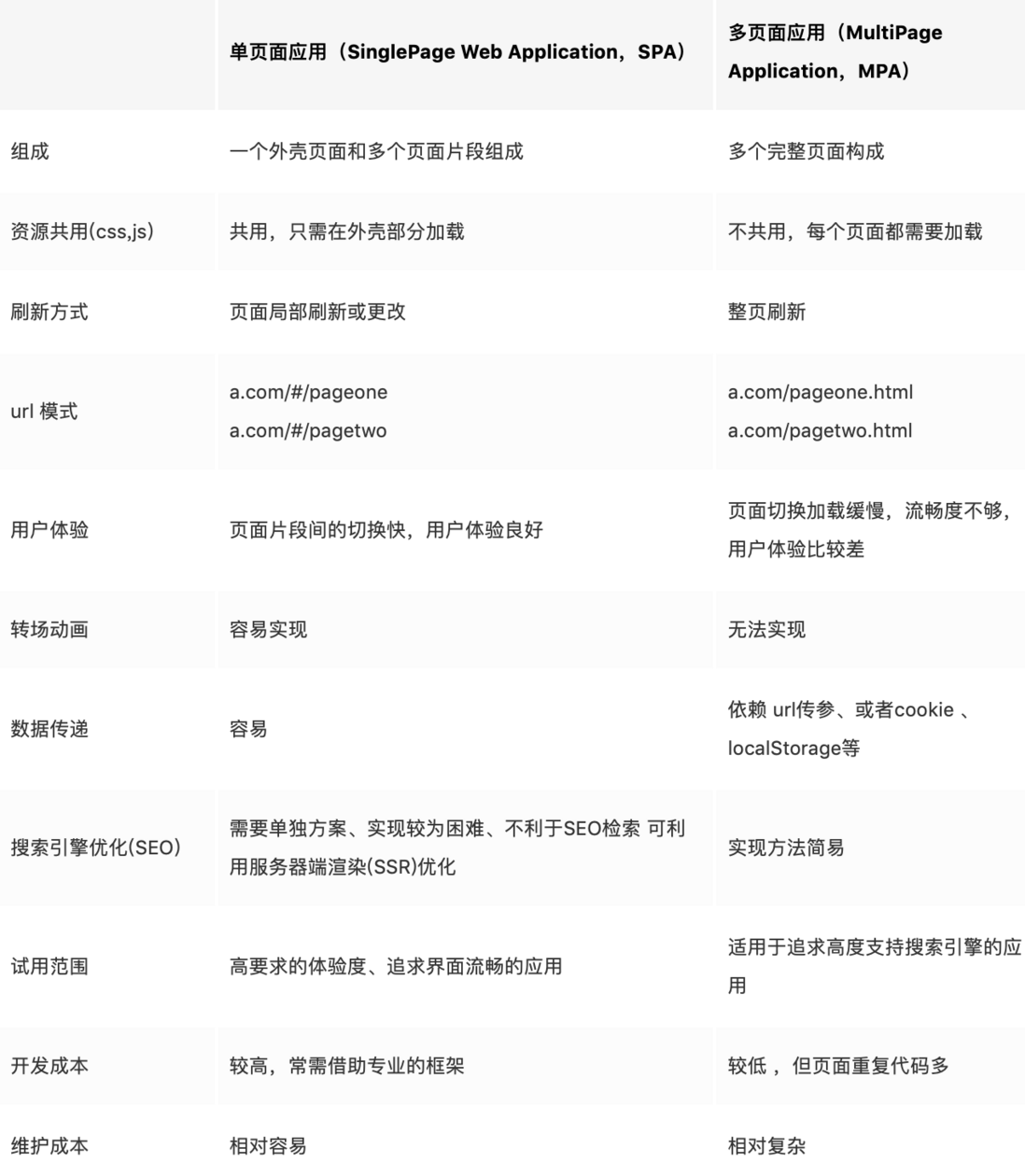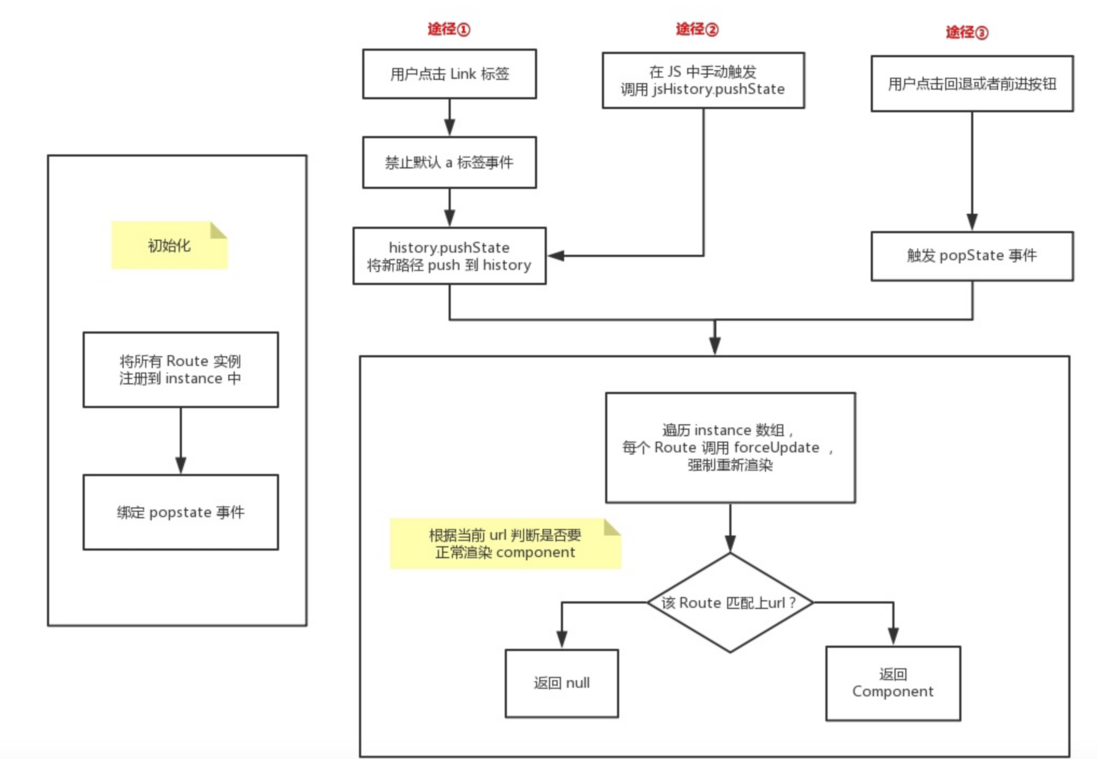随着React Vue前端框架的兴起,出现了Vue-router,react-router-dom等前端路由管理库,利用他们构建出来的单页面应用,也是越来越接近原生的体验,再也不是以前的点击标签跳转页面,刷新整个页面了,那么他们的原理是什么呢?
优质gitHub开源练手项目:
先说说原始的MPA多页面应用:
文末还有新建的QQ以及微信群哦~ 欢迎大家加入~~
传统的多页面应用构建方式:
- 纯服务端渲染,前后端不分离,使用
jsp,jade,'ejs','tempalte'等技术在后台先拼接成对应的HTML结构,然后转换成字符串,在每个对应的路由返回对应的数据(文件)即可
Jade模版服务端渲染,代码实现:
const express= require('express')
const app =express()
const jade = require('jade')
const result = ***
const url path = ***
const html = jade.renderFile(url, { data: result, urlPath })//传入数据给模板引擎
app.get('/',(req,res)=>{
res.send(html)//直接吐渲染好的`html`文件拼接成字符串返回给客户端
}) //RestFul接口
app.listen(3000,err=>{
//do something
})
- 使用
jQuery等传统库绘制的前端页面
传统前后端不分离,服务端渲染的优缺点:
优点:
-
SEO友好,因为返回给前端的是渲染好的HTML结构,里面的内容都可以被爬虫抓取到。 - 对于一些应用性能等要求不高的项目,比如某个公司的静态网页,内容很少的情况下,直接一把梭就好,不用再搭建工程化的环境等
- 对于后端程序员(全干工程师)来说,不用去特意学习前端框架,公司也不用特意去招聘前端
- 兼容性好,传统服务端渲染多页面应用吐出来的都是字符串,
HTML结构
缺点:
- 如果项目很大,不利于维护,据我所知,目前很多云计算公司,还有不少都是使用非单页面应用,例如一个几十万行的项目是用
jQuery写的,如果注释和文档不是非常齐全,那么真的会无从下手 - 性能和用户体验,不能跟单页面应用相比
- 后期迭代,升级空间不大,目前大部分写得比较好的库,都建立
vue,react等框架基础上,他们都有一套自己的运行机制,有自己的生命周期,并且不像传统的应用,还加上了一层虚拟DOM以及diff算法 - 现在类似
Ant-Design-pro这样的开箱即用的库已经很多,单页面应用的学习和开发成本已经很低很低,如果还在使用传统的技术去开发新的应用,对于开发人员多内心来说也是一种折磨。
这里并不是说多页面应用不好,只能说各有各自的好,单页面应用如果通过大量的极致优化手段,是可以从不少方面跟原生一拼。
目前的单页面应用:
- 只有一张Web页面的应用,是一种从Web服务器加载的富客户端,单页面跳转仅刷新局部资源 ,公共资源(js、css等)仅需加载一次,常用于PC端官网、购物等网站
- 其实只有一个空的
DIV标签,其他都是js动态生态的内容
单页面应用实现步骤:
代码实现:
- 首先是一个静态模板文件
index.html
<!DOCTYPE html>
<html lang="en">
<head>
<meta charset="UTF-8">
<meta name="viewport" content="width=device-width, initial-scale=1.0">
<meta http-equiv="X-UA-Compatible" content="ie=edge">
<title>Document</title>
</head>
<body>
<div id="root"></div>
</body>
<script>
</script>
</html>- 在
vue react框架的入口文件中指定对应的渲染元素:
import React from 'react;
import ReactDOM from 'react-dom';
ReactDOM.render(
<App/>,
document.querySelector("#root")
)
- 引入
react-router或者 react-router-dom,dva等路由跳转的库 - 配置路由跳转
<HashRouter>//这里使用HashRouter
<ErrorBoundary>//React错误边界
<Switch>
<Route path="/login" component={Login} />
<Route path="/home" component={Home} />
<Route path="/" component={NotFound} />//404路由或者重定向都可以
</Switch>
</ErrorBoundary>
</HashRouter>单页面应用所谓路由跳转,其实最终结果就是:
- 浏览器的
url地址发生变化,但是其实并没有发送请求,也没有刷新整个页面 - 根据我们配置的路由信息,每次点击切换路由,会切换到不同的组件显示,类似于选项卡功能的实现,但是同时
url地址栏会变化 - 分为
HashRouter和BrowserRouter两种模式
自己实现一个粗略的路由跳转:
自己实现传统的Hash模式跳转:
hash 就是指 url 后的 # 号以及后面的字符。例如www.baidu.com/#segmentfault,那么#segmentfault就是hash值
-
需要用到的几个知识点:
-
window.location.hash= '**'; // 设置当前的hash值 -
const hash = window.location.hash获取当前的hash值 -
hash改变会触发window的hashchange事件
-
window.onhashchange=function(e){
let newURL = e.newURL; // 改变后的新 url地址
let oldURL = e.oldURL; // 改变前的旧 url地址
}
这里特别注意,hash改变并不会发送请求
开始实现Hash模式跳转:
使用类似发布订阅模式的方式,使用ES6的class实现:
- 初始订阅,每个不同的
hash值,对应不同的函数调用处理。
class Router {
constructor() {
this.routes = {};
this.currentUrl = '';
}
route(path, callback) {
this.routes[path] = callback || function() {};
}
updateView() {
this.currentUrl = location.hash.slice(1) || '/';
this.routes[this.currentUrl] && this.routes[this.currentUrl]();
}
init() {
window.addEventListener('load', this.updateView.bind(this), false);
window.addEventListener('hashchange', this.updateView.bind(this), false);
}
}
- routes 用来存放不同路由对应的回调函数
- init 用来初始化路由,在 load 事件发生后刷新页面,并且绑定 hashchange 事件,当 hash 值改变时触发对应回调函数
开始使用:
<div id="app">
<ul>
<li>
<a href="#/">home</a>
</li>
<li>
<a href="#/about">about</a>
</li>
<li>
<a href="#/topics">topics</a>
</li>
</ul>
<div id="content"></div>
</div>
<script src="js/router.js"></script>
<script>
const router = new Router();
router.init();
router.route('/', function () {
document.getElementById('content').innerHTML = 'Home';
});
router.route('/about', function () {
document.getElementById('content').innerHTML = 'About';
});
router.route('/topics', function () {
document.getElementById('content').innerHTML = 'Topics';
});
</script>这样一个简单的hash模式路由就做好了,剩下的就是路由嵌套,以及错误边界的处理
History模式实现:
-
History来自Html5的规范 -
History模式,url地址栏的改变并不会触发任何事件 -
History模式,可以使用history.pushState,history.replaceState来控制url地址,history.pushState() 和 history.replaceState() 的区别在于:-
history.pushState()在保留现有历史记录的同时,将 url 加入到历史记录中。 -
history.replaceState()会将历史记录中的当前页面历史替换为 url。
-
-
History模式下,刷新页面会404,需要后端配合匹配一个任意路由,重定向到首页,特别是加上Nginx反向代理服务器的时候
我们需要换个思路,我们可以罗列出所有可能触发 history 改变的情况,并且将这些方式一一进行拦截,变相地监听 history 的改变。
对于一个应用而言,url 的改变(不包括 hash 值得改变)只能由下面三种情况引起:
- 点击浏览器的前进或后退按钮
- 点击 a 标签
- 在 JS 代码中触发 history.push(replace)State 函数
只要对上述三种情况进行拦截,就可以变相监听到 history 的改变而做出调整。针对情况 1,HTML5 规范中有相应的 onpopstate 事件,通过它可以监听到前进或者后退按钮的点击,值得注意的是,调用 history.push(replace)State 并不会触发 onpopstate 事件。
开始实现:
class Router {
constructor() {
this.routes = {};
this.currentUrl = '';
}
route(path, callback) {
this.routes[path] = callback || function() {};
}
updateView(url) {
this.currentUrl = url;
this.routes[this.currentUrl] && this.routes[this.currentUrl]();
}
bindLink() {
const allLink = document.querySelectorAll('a[data-href]');
for (let i = 0, len = allLink.length; i < len; i++) {
const current = allLink[i];
current.addEventListener(
'click',
e => {
e.preventDefault();
const url = current.getAttribute('data-href');
history.pushState({}, null, url);
this.updateView(url);
},
false
);
}
}
init() {
this.bindLink();
window.addEventListener('popstate', e => {
this.updateView(window.location.pathname);
});
window.addEventListener('load', () => this.updateView('/'), false);
}
}Router 跟之前 Hash 路由很像,不同的地方在于:
- init 初始化函数,首先需要获取所有特殊的链接标签,然后监听点击事件,并阻止其默认事件,触发 history.pushState 以及更新相应的视图。
- 另外绑定 popstate 事件,当用户点击前进或者后退的按钮时候,能够及时更新视图,另外当刚进去页面时也要触发一次视图更新。
实际使用:
<div id="app">
<ul>
<li><a data-href="/" href="#">home</a></li>
<li><a data-href="/about" href="#">about</a></li>
<li><a data-href="/topics" href="#">topics</a></li>
</ul>
<div id="content"></div>
</div>
<script src="js/router.js"></script>
<script>
const router = new Router();
router.init();
router.route('/', function() {
document.getElementById('content').innerHTML = 'Home';
});
router.route('/about', function() {
document.getElementById('content').innerHTML = 'About';
});
router.route('/topics', function() {
document.getElementById('content').innerHTML = 'Topics';
});
</script>- 跟之前的 html 基本一致,区别在于用 data-href 来表示要实现软路由的链接标签。
- 当然上面还有情况 3,就是你在 JS 直接触发 pushState 函数,那么这时候你必须要调用视图更新函数,否则就是出现视图内容和 url 不一致的情况。
setTimeout(() => {
history.pushState({}, null, '/about');
router.updateView('/about');
}, 2000);
React-router-dom源码:
Router组件:
export class Route extends Component {
componentWillMount() {
window.addEventListener('hashchange', this.updateView, false);
}
componentWillUnmount() {
window.removeEventListener('hashchange', this.updateView, false);
}
updateView = () => {
this.forceUpdate();
}
render() {
const { path, exact, component } = this.props;
const match = matchPath(window.location.hash, { exact, path });
if (!match) {
return null;
}
if (component) {
return React.createElement(component, { match });
}
return null;
}
}
- 组件挂载监听
hash change原生事件,将要卸载时候移除事件监听防止内存泄漏 - 每次
hash改变,就触发所有对应hash的回掉,所有的Router都去更新视图 - 每个
Router组件中,都去对比当前的hash值和这个组件的path属性,如果不一样,那么就返回null,·否则就渲染这个组件对应的视图
History模式的实现:
这里想多留些时间写其他源码,这篇文章写得非常好,大家也可以去看看,本文很多借鉴他的。
withRouter高阶函数的源码:
var withRouter = function withRouter(Component) {
var C = function C(props) {
var wrappedComponentRef = props.wrappedComponentRef,
remainingProps = _objectWithoutProperties(props, ["wrappedComponentRef"]);
return _react2.default.createElement(_Route2.default, {
children: function children(routeComponentProps) {
return _react2.default.createElement(Component, _extends({}, remainingProps, routeComponentProps, {
ref: wrappedComponentRef
}));
}
});
};
C.displayName = "withRouter(" + (Component.displayName || Component.name) + ")";
C.WrappedComponent = Component;
C.propTypes = {
wrappedComponentRef: _propTypes2.default.func
};
return (0, _hoistNonReactStatics2.default)(C, Component);
};- 传入一个组件,返回一个新的组件,并且给这个组件赋予全局属性,拥有路由组件的三大属性
Switch组件:
Switch.prototype.render = function render() {
var route = this.context.router.route;
var children = this.props.children;
var location = this.props.location || route.location;
var match = void 0,
child = void 0;
_react2.default.Children.forEach(children, function (element) {
if (match == null && _react2.default.isValidElement(element)) {
var _element$props = element.props,
pathProp = _element$props.path,
exact = _element$props.exact,
strict = _element$props.strict,
sensitive = _element$props.sensitive,
from = _element$props.from;
var path = pathProp || from;
child = element;
match = (0, _matchPath2.default)(location.pathname, { path: path, exact: exact, strict: strict, sensitive: sensitive }, route.match);
}
});
return match ? _react2.default.cloneElement(child, { location: location, computedMatch: match }) : null;
};- 遍历所以传入的子元素
- 如果有符合的路由对应的元素,那么就返回,而且只匹配这一个路由。不再继续往下匹配
- 如果第二条没有找到符合的元素,那么抛出错误
如果觉得写得好,记得点个赞哦,另外新建了微信和QQ群,欢迎各位小哥哥小姐姐入驻~
- 微信群:
- QQ群





**粗体** _斜体_ [链接](http://example.com) `代码` - 列表 > 引用。你还可以使用@来通知其他用户。